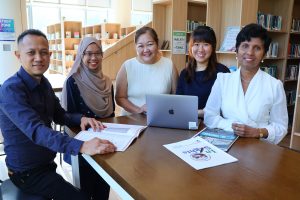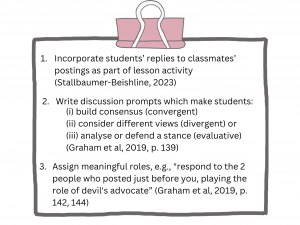Why Singapore’s English Teachers Should Embrace Singlish, Not Fight It
Is it time for Singaporean educators to embrace Singlish as a legitimate learning tool? What the Research […]
Read More
Contributed by Ms Tan Yen Chuan and Ms Hafizah Jumat, Centre for Pedagogical Research and Learning, Raffles Girls’ School (Secondary), for SingTeach Virtual Staff Lounge

The team comprises (from left) Azahar Noor, Hafizah Jumat, Tan Yin Lai, Tan Yen Chuan, Mary George Cheriyan and Lucille Yap (not in picture).
Have you ever wondered what students really think about blended learning? Or how their experiences can enhance our teaching practices? In this article, Ms Tan Yen Chuan and Ms Hafizah Jumat, from the Raffles Girls’ School Centre for Pedagogical Research and Learning (PeRL) share insights from a study on students’ perceptions and experiences of blended learning which involved a survey of over 500 students and focus group discussions conducted with approximately 20 students from a secondary school. This article highlights both good practices and areas where teachers can better understand and support students in their blended learning journey.
Self-regulated learning (SRL) refers to one’s ability to understand and control one’s learning environment (Zimmerman, 2002). SRL abilities which include goal setting, self-monitoring, self-instruction, and self-reinforcement (Harris & Graham, 1999; Schraw, Crippen, & Hartley, 2006; Shunk, 1996), are vital in the blended learning (BL) environment, where students have their own personal learning devices (PLDs). They must be able to use strategies to minimize distractions, manage their time and exercise self-control to complete assigned work.
Based on the survey findings, the students felt they were able to use online tools, assessment data, model answers and teacher feedback to guide, monitor and improve their performance. They also employed a help-seeking process and sought teachers’ feedback for further clarifications to improve their learning. Majority of them were able to apply digital literacy skills to evaluate the credibility of online information.
On the other hand, during the focus group discussions (FGDs), some students reported being easily distracted by their PLDs. Their off-task behaviours can affect neighbouring students as well. Therefore, it is important for teachers to empower students to advocate for themselves as learners. Besides providing varied learning activities to increase student engagement, teachers can consider nurturing their executive functioning skills on minimizing distraction, environment control, planning, and time-management. Teachers should also demonstrate breaking down a task into actionable steps to help them learn how to complete tasks independently. Additionally, creating opportunities for student self-reflection and self-evaluation is important, requiring teachers to designate time and space in the BL environment for self-reflection (whether offline or face-to-face).
Our findings showed the students felt their teachers helped them see their learning progress using online and offline assessment data. They also find teacher feedback helpful as it is tailored to address their learning gaps.
However, a minority of students wanted more prompt feedback on their online assignments. To address this, teachers can consider harnessing approaches like the Station Rotation Model to provide timely feedback during face-to-face lessons. As this model includes both online and face-to-face stations as part of the rotation process, this means teachers can provide feedback in real time on these online assignments as students work on them during class time. Under this model, teachers can also offer personalized instruction, feedback, and support to students individually or in small groups (Tucker, Wycoff & Green, 2016).
Given the nature of BL, teachers may assign both hardcopy homework and online homework to facilitate flipped classroom teaching or home-based learning. However, this combination may potentially overwhelm students, especially with limited completion time. Schools can help ensure a manageable workload by periodically surveying students’ homework demand. Teachers should engage students in setting realistic deadlines, expectations and scope of tasks. Teachers should also assess students’ homework load and provide support to help them manage their workload effectively.
While students value peer feedback, the majority would not respond to their classmates’ online postings if their responses were not graded. They felt such activity was not important or useful for their learning. Teachers need to communicate to students how such activity can foster deeper understanding and value add to their knowledge-building as well as improve netiquette skills (Harmonize, 2023). Teachers can also employ the following strategies to maximize the benefits of online peer feedback:

Teachers can cultivate positive habits in students by mandating students’ responses to classmates’ postings. As students overcome the initial hurdle of participation and become accustomed to responding, they are more likely to sustain online discussions voluntarily.
As BL incorporates digital tools and platforms for learning, the role of AI in education has become more prominent. During our FGD sessions, when we asked students about the apps they use to complete their homework, the use of ChatGPT was mentioned. Although this study did not initially focus on AI, its relevance and significance were highlighted by the students through these discussions on their BL experience, underscoring the need for educators to engage in conversations and establish guidelines for AI use in their BL journey.
It is essential to develop their AI literacy and promote the ethical use of technology in line with the Ministry of Education’s EdTech Masterplan 2030.
AI integration is inevitable. Karim R. Lakhani aptly stated, “AI is not going to replace humans, but humans with AI are going to replace humans without AI” (AI Won’t Replace Humans, 2023). It is vital to convey to students that values matter and technology should be used for good, emphasizing that the thinking process remains central to learning.
We hope that teachers can leverage these findings to refine their instructional strategies and support structures to better meet the students’ needs in BL settings.
References
Harvard Business Review. (2023, August 4). AI Won’t Replace Humans — But Humans With AI Will Replace Humans Without AI. https://hbr.org/2023/08/ai-wont-replace-humans-but-humans-with-ai-will-replace-humans-without-ai
Graham, C. R., Borup, J., Short, C. R., & Archambault, L. (2019). K-12 blended teaching: A guide to personalized learning and online integration. EdTechBooks. org: Provo, UT, USA
Harmonize. (2023, January 23). How to respond to discussion posts. Harmonize Blog. https://harmonizelearning.com/blog/how-to-respond-to-discussion-posts/
Harris, K. R., & Graham, S. (1999). Programmatic intervention research: Illustrations from the evolution of self-regulated strategy development. Learning Disability Quarterly, 22(4), 251–262. https://doi.org/10.2307/1511259
Schraw, G., Crippen, K. J., & Hartley, K. (2006). Promoting Self-Regulation in Science Education: Metacognition as Part of a Broader Perspective on Learning. Research in Science Education, 36(1), 111-139. https://doi.org/10.1007/s11165-005-3917-8
Shunk, D. (1996). Goal and self-evaluative influences during children’s cognitive skill learning. American Educational Research Journal, 33, 359-382.
Stallbaumer-Beishline, L. (2023, June 1). Discussion Boards: Better Practices & Tips [PDF file]. Bloomsburg Commonwealth University. https://www.bloomu.edu/documents/ctl-ttdiscussion-boards-v2.pdf
Tucker, C. R., Wycoff, T., & Green, J. T. (2016). Blended Learning in Action: A Practical Guide Toward Sustainable Change. California: Corwin, a SAGE company.
Zimmerman, B. J. (2002). Becoming a Self-Regulated Learner: An Overview. Theory Into Practice, 41(2), 64–70. https://doi.org/10.1207/s15430421tip4102_2